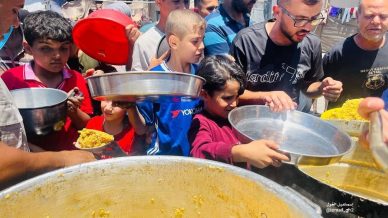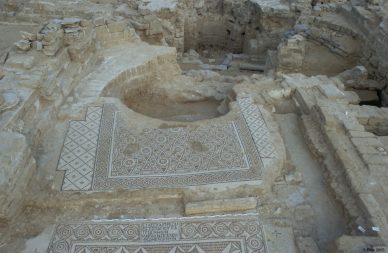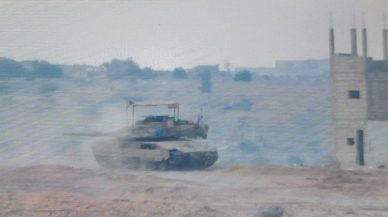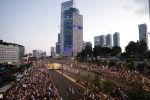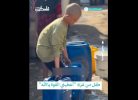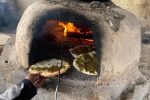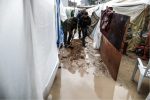By Charles Arthur
You see the black and white scarf everywhere, worn by hundreds of thousands of people standing up for Palestine and protesting against the ethnic cleansing and genocide committed by Israel. But ever wondered where these keffiyehs (also spelt kufiya) are made?
The short answer is that most are made in China. Originally, keffiyehs were made by weavers in Palestine or by Palestinians expelled from their homeland when Israel was created in 1948. Individual weavers and small businesses served the local and regional markets.
Then, in the mid-1990, when global demand for the Palestinian keffiyeh started to take off, companies in China moved to mass produce this item. In a short time, Chinese and also Indian products came to dominate the global market for keffiyehs, even conquering the Arab market, including Palestine itself.
When, in 1961, the Hirbawi factory opened in Hebron, the largest city in the subsequently occupied West Bank, it was one of 30 factories weaving keffiyehs. But Palestinian manufacturers could not compete with the pace or scale of output of the foreign textile companies, nor with their low prices (today, an online search shows that bulk wholesale orders for Palestinian headscarves from companies in China can start at prices of around two-to-three US dollars apiece).
In the year 2000, Hirbawi had to close down and, by the time it reopened in 2007, it was the only manufacturer left in Palestine. It slowly rebuilt its business but struggled to compete with overseas suppliers. In addition, as is the case for all small businesses in the Occupied Palestinian Territories, Hirbawi’s production and trade were hampered by the checkpoints and roadblocks erected by the Israeli army.
In the calendar year 2010, Hirbawi produced just 10,000 scarves, compared to 150,000 during the peak year of 1993. On the brink of collapse again, Hirbawi was saved by the Internet. A company website and then a Facebook page first helped Hirbawi reach foreign customers.
Then, in 2012, Hirbawi began working with Palestinians in Germany and launched kufiya.org, an online shop based in Germany, to sell keffiyehs to private customers worldwide. International sales got a further boost in 2015 when a North American online outlet was set up.
Since Israel’s military assault on the Gaza Strip beginning in October 2023, demand for keffiyehs as a symbol of solidarity with Palestinians has surged. Reuters reported that, according to the e-commerce analytics firm Jungle Scout, in the two months after 7 October 2023 sales of keffiyehs on Amazon rose 75% compared with the previous two months.
While Hirbawi benefitted from this uptick in demand in general, it also became clear that many customers were prepared to pay more for their scarves on the grounds of quality and authenticity.
Palestinian-made keffiyehs use high-quality cotton and craftsmanship to ensure comfort and durability, whereas the mass-produced scarves from China and India make do with cheaper fibres of variable quality, often synthetic. In addition, the designs for Palestinian-made keffiyehs are considered authentic, often passed down through generations, while Chinese and Indian-made scarves often fail to adhere to traditional patterns.
In the first few weeks of the Israeli invasion of Gaza, Hirbawi sold 20,000 scarves, and a restock of 5,000 keffiyehs sold out within 12 hours. Over a year after the Israeli invasion and siege of Gaza began, demand for this symbolic item remains strong and Hirbawi’s monthly restock is still selling out almost immediately.
Hirbawi’s relatively healthy sales are doubtless driven to some extent by politically engaged customers who want their purchases to support the economy of Palestine, and it makes the most of its status as “the last keffiyeh factory in Palestine”. However, a competitor has recently emerged in the shape of the reborn Alnabulsi Textile Factory.
It was founded in early 1950s by the al-Nabulsi family in the West Bank city of Nablus (and thus is also known as the Nablus Textile Company). It enjoyed some success as a manufacturer of school uniforms, as well as keffiyehs, but the Israeli occupation, with its severe restrictions on movement and access to raw materials, forced its closure in 1985. In late 2023, the factory resumed operations, and keffiyehs are now available from PaliRoots and Hala Palestine, amongst others.
Another option for keffiyehs made by Palestinians, but not made in Palestine, is the Golden Textile Factory in Amman, the capital of Jordan. The Bulbul family business was originally located in Jericho in the West Bank but, in the aftermath of the 1967 Arab-Israeli War, the family were among 300,000 Palestinians driven out of the territory by the Israelis. They settled in Al Wehdat refugee camp, established by the UNRWA in the south-eastern part of Amman, and rebuilt their company, primarily producing keffiyehs, available online from KUVRD and Handmade Palestine.
The popularity of the keffiyeh as a symbol of solidarity with the Palestinian cause, and specifically of protest against the genocide in Gaza, is driving international demand that is met by online shopping. Palestinian keffiyeh manufacturers are currently riding this wave but the Israeli occupation continues to wreak havoc along the entire value chain.
Cotton was once an important crop grown in Palestine. Indeed, there is a perhaps apocryphal tale of how, long ago, Gaza, where cotton was grown and weaving was an important economic activity, gave its name to gauze, the light, open-weave fabric made of cotton that is used for surgical dressings.
The establishment of Israel in 1948 and the 1948-9 war resulted in Israel taking land on the Mediterranean coastal plains and the Hula Valley region near the border with Lebanon where conditions for growing cotton were optimal. Palestinian farmers were displaced, their lands taken by Israeli settlers.
Following Israel’s occupation of the West Bank after the Six-Day War in 1967, restrictions on water access, land use and the movement of people and goods imposed by the Israeli occupation have continued to impact Palestinian farmers.
In 2022 – the latest year with available data – Palestine’s cotton production was meagre and trade was totally beholden to Israel. All Palestinian cotton exports, with a value of just US$1.7m., went to Israel, while Palestinian cotton imports, valued at US$2.1m, came primarily from Egypt and Israel.
As long as the Israeli occupation continues to strangle the people and economy of Palestine, the continued survival of the last Palestinian keffiyeh manufacturers is reliant on the willingness of politically engaged consumers around the world to pay more for authentic, quality scarves.
-Charles Arthur is a former communications officer at the UN Industrial Development Organization. His article appeared in MEMO.



